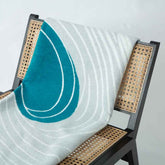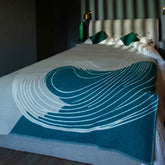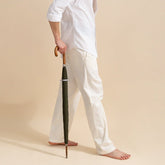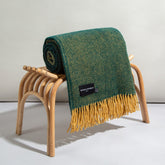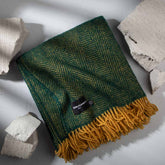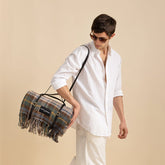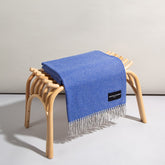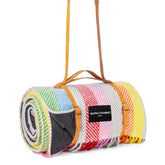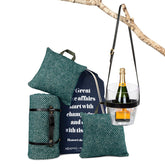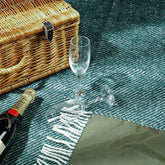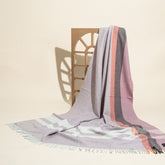All You Wanted to Know about Merino Wool
Merino wool, a natural fibre acclaimed for its exceptional softness, warmth, and moisture-wicking properties, has a unique place in the world of textiles. Originating from the esteemed Merino sheep, this wool has become synonymous with luxury and comfort, coveted by fashion enthusiasts, outdoor adventurers, and environmentally conscious consumers alike.
See our beautiful Merino wool blanket collection here.
But what sets Merino wool apart from other types of wool? Why has it become a preferred choice in everything from high-end fashion to athletic wear? This article aims to unravel the fascinating world of Merino wool, delving into its origins, characteristics, production processes, and diverse applications.
Whether you're a curious shopper seeking the best quality garments, a hobbyist knitter eager to work with top-grade material, or someone intrigued by sustainable and ethical textile practices, join us on this woolly journey as we discover the richness and versatility of a material that has woven its way into the very fabric of our daily lives.
The Merino Sheep
The Merino sheep are renowned for their finely crimped and soft wool, boasting attributes that set them apart from other breeds. The quality of their fleece is unparalleled, with fine fibres that can be as thin as 12-24 microns, giving it an incredibly soft and luxurious feel. Their dense fleece allows for more fibres, contributing to the wool's excellent insulation properties. Some Merino sheep also have wrinkles in their skin, increasing the surface area to produce more wool, though this characteristic has led to ethical considerations in some farming practices.

Originally hailing from Spain, Merino sheep have since spread across the globe. Australia is the largest producer of Merino wool, with different strains adapted to various climates. New Zealand is known for ethical farming practices and a focus on fine and ultra-fine wool. South Africa specialises in strong and robust wool suitable for a range of products, while regions like Uruguay and Argentina in South America have developed their own Merino wool industry with a focus on sustainability.
Breeding Merino sheep is an intricate process requiring attention to various factors. Farmers often select sheep with desirable characteristics such as fleece quality and body size. Shearing is usually done annually, with care taken to ensure the sheep's comfort and health. Nutrition, shelter, and medical care are equally crucial in maintaining healthy sheep and producing quality wool.
Merino wool plays a vital role in the economies of the regions where it's produced. It's a source of employment, creating jobs from farming to processing, and sustains many livelihoods. Being a valuable commodity, Merino wool also contributes significantly to export revenue, especially in countries like Australia. With the growing emphasis on ethical and sustainable practices, Merino wool farming aligns with responsible economic development.
Properties of Merino Wool
Merino wool is admired for its unique physical and chemical properties. Composed of protein molecules called keratin, the same protein found in human hair and nails, the fibres exhibit a natural crimp. This crimping not only adds to the soft texture but also creates tiny insulating air pockets. The fibres are coated with a thin layer of lanolin, a natural wax, providing water-repellent properties.
One of the standout features of Merino wool is its ability to regulate temperature. The wool can absorb moisture up to one-third of its dry weight, releasing it slowly, thus keeping the skin dry and regulating body temperature. In hot weather, the moisture evaporates, cooling the body, while in cold conditions, the retained moisture heats up, providing warmth.
While wool, in general, shares some common features, Merino wool is distinctive for its fineness and softness. Traditional wool can be coarse and sometimes itchy, but Merino wool is often softer and more comfortable against the skin. Its elasticity and strength set it apart from other wool types, making it more durable and resistant to wear and tear.
The characteristics of Merino wool make it suitable for a wide range of applications. Its insulating properties make it ideal for winter clothing, while its moisture-wicking ability suits athletic and outdoor wear. The natural breatheability and odour resistance are favoured in daily fashion. Even in home décor, Merino wool's luxurious feel and appearance add a touch of elegance and comfort.
Production and Processing
The production of Merino wool begins with the shearing of the sheep. This delicate process requires skilled shearing professionals who can remove the fleece without harming the animal. Modern techniques involve using electric shears, which are efficient and cause minimal discomfort to the sheep. There are also manual methods that emphasise tradition and may cater to specific market demands.

Once the wool is sheared, it goes through a series of processes to transform it into usable yarn. Cleaning and carding remove impurities and untangle the fibres. Spinning then twists the fibres into a continuous thread, and weaving or knitting turns the thread into fabric. The fineness of Merino wool requires specialised equipment and experienced craftsmanship to preserve its quality during these stages.
The production of Merino wool has been the focus of ethical considerations and scrutiny. Concerns include the well-being of the sheep, especially related to practices like mulesing, and fair labour practices in the shearing and processing stages. Many producers are adopting transparent and humane practices to address these concerns, with certifications available to assure consumers of ethical sourcing.
Merino wool's natural origins give it potential sustainability benefits, such as biodegradability and renewable production. However, the environmental impact of wool farming, including water and land use, must be carefully managed. Sustainable practices include responsible grazing, organic farming methods, and water management. Some producers even engage in carbon-neutral or carbon-negative practices to further minimise environmental harm.
Uses and Applications
Merino wool has long been a staple in the fashion industry, renowned for its ability to combine luxury with comfort. Designers often choose Merino for its drape and soft texture, creating elegant garments ranging from fine suits to delicate dresses. The wool's natural luster enhances the richness of colours, making it a versatile fabric for both classic and contemporary fashion styles. (1)
The temperature-regulating and moisture-wicking properties of Merino wool make it particularly well-suited for sports and outdoor activities. Hikers, runners, and cyclists appreciate the lightweight insulation it provides, keeping them warm in cold conditions and cool in heat. Its natural resistance to odours also makes Merino wool a favoured material for extended wear during camping or long-distance trekking.
Merino wool's gentleness against the skin and hypoallergenic properties have made it a popular choice for baby products. From blankets to onesies, the soft texture provides comfort without irritation, even for sensitive skin. Its natural ability to maintain an ideal body temperature makes it suitable for year-round use, contributing to the well-being and comfort of infants.
Beyond clothing, Merino wool has found its way into home décor and furnishings. Its aesthetic appeal, coupled with functional benefits, makes it a preferred material for items like rugs, throws, and upholstery. The warmth and luxurious touch it adds to interiors are complemented by its durability, ensuring that Merino wool pieces are not only beautiful but long-lasting.
Artists and craft enthusiasts have also discovered the joys of working with Merino wool. Whether it's in the form of felt for sculptures, intricate embroidery, or hand-knitted creations, the wool's unique texture and quality offer endless creative possibilities. Workshops and online communities dedicated to Merino wool crafts testify to its growing popularity among creative minds.
Care and Maintenance of Merino Wool
Proper care begins with understanding the care labels on Merino wool products. These labels contain vital information, including washing temperature, drying instructions, and whether the item can be ironed or dry-cleaned. Following these instructions is essential to maintaining the wool's quality and appearance.
Merino wool requires gentle handling during washing and drying. Using mild wool detergent and cold water helps preserve the fibres' integrity. While some items may be machine-washable on a gentle cycle, hand-washing is often recommended. Drying should be done by laying the item flat, away from direct heat or sunlight, to prevent shrinking or distortion.
Storing Merino wool properly ensures its longevity. The wool should be clean and dry before storage to prevent moths or mildew. Using breathable garment bags or containers allows the wool to maintain its natural moisture balance. Cedar blocks or lavender sachets can add protection against pests without damaging the fibres.
Immediate attention to stains can prevent lasting damage. Blotting (not rubbing) with cold water and gentle detergent usually removes fresh stains. For persistent or old stains, professional cleaning may be necessary. Small holes or tears can often be mended at home with careful stitching, or a professional tailor may be sought for significant repairs.
Choosing environmentally friendly detergents and minimising water and energy use during cleaning align with the sustainable nature of Merino wool. Repairing and reusing Merino wool products, instead of discarding them, also contributes to a sustainable lifestyle, reflecting the ethical considerations often associated with this material.
Choosing and Buying Merino Wool Products
When purchasing Merino wool products, you’ll want to recognise the quality indicators. Look for information on fibre thickness, measured in microns, as a finer fibre usually translates to softer wool. The quality also depends on factors like purity, colour, and the absence of defects.
Not all products labelled as Merino wool are genuine. Authenticity can be ensured by purchasing from reputable brands, looking for certifications, or checking the product's origin. Information on labels and packaging can also provide insights into the wool's authenticity.
If ethics and sustainability are vital to your purchasing decisions, seek out Merino wool products that are certified as humanely sourced, organic, or produced with responsible environmental practices. Brands that are transparent about their supply chain practices can provide confidence in these aspects.



























